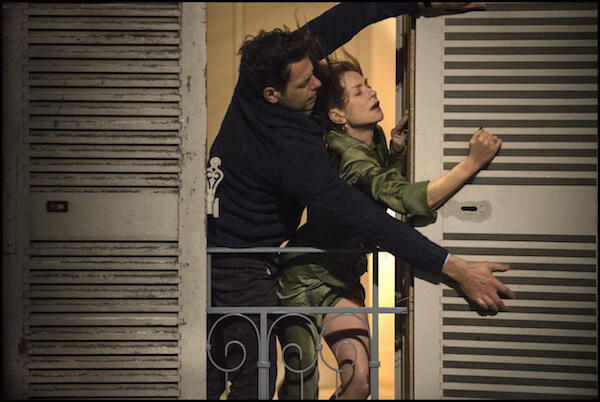Paul Hamy in João Pedro Rodrigues’ “The Ornithologist.” | STRAND RELEASING
In João Pedro Rodrigues’ fascinating new film, “The Ornithologist,” the title character Fernando (Paul Hamy) is kayaking through Portugal studying black storks. After he has an accident, two Chinese hikers, Fei (Han Wen) and Ling (Chan Suan), who have strayed from the Camino de Santiago, save him. Fernando has a series of further adventures, meeting Jesus (Xelo Cagiao), a deaf shepherd, and some bare-breasted hunters (Juliane Elting, Flora Bulcao, and Isabelle Puntel).
The film makes all of Fernando’s encounters compelling, and he is compelling to watch when he is on his own. “The Ornithologist” can also be read as a contemporary and queer allegory for St. Anthony of Padua’s pastoral care of lost people. Rodrigues peppers the film with illusions throughout, from Fernando talking to fishes to being baptized in an unusual way.
Paul Hamy an object of keen interest in mezmerizing allegory
The filmmaker spoke via Skype with Gay City News about making “The Ornithologist.”
GARY M. KRAMER: Where did you film “The Ornithologist,” and how did you get all the birding footage?
JOÃO PEDRO RODRIGUES: I shot in northeastern part of Portugal, Trás os Montes, along the river Douro, which creates the border between Portugal and Spain. The bird footage I shot a year before the actors. And I adapted the script to that footage. I was a Radcliff Fellow at Harvard, and I was thinking about those images. When you film birds, you don’t know what they are because they are wild. I filmed the black stork because it’s a lonely, solitary bid that hides and nests in river canyons. It’s a double for Fernando. It’s an uncommon bird.
GMK: You shoot overhead (a bird’s eye view) but also through binoculars, creating an element of voyeurism throughout “The Ornithologist.” Can you talk about that and how it is a theme in your work?
JPR: I think it comes from my wanting to be an ornithologist. I was always a voyeur in a way. With binoculars, you are being a voyeur, but a bit detached and far way from the object you are seeing, a bird or something. My films are always a bit like that — observing my actors. There is always a little bit of a distance because it’s never very emotional. It comes from my past studying biology and wanting to study science before being a filmmaker. It’s observational, and that is me looking at people or the world from my own point of view.
GMK: On that note, Paul Hamy gives a remarkable, full-bodied performance. Can you talk about how he is fetishized in the film? He is tied up in his underwear like St. Sebastian, seen sunbathing naked, and even getting a golden shower as a kind of baptism.
JPR: In a way, when I choose an actor it’s a form of sublimating a desire. I have to desire an actor in a way to film them. It’s part of that and why I’m so interested in more physical performance. It was hard for Paul to be strung up, but we rehearsed that scene, and I rehearsed it on myself. The girl who helped us was a bondage expert who helped tie him and shoot him. We shot that scene over three days. It was very hard. There was always a way that if he felt bad, we could untie him quickly. It’s important he had this suffering and can communicate that to be real to anyone who sees the film. He had to suffer. These demands are, I think, the only way to get these performances from the actors. There’s a connection with suffering.
GMK: There is a journey of identity, lost and found, in “The Ornithologist” which also is a theme that you have used in all of your features — how people (re)present or create themselves. Can you discuss these themes in your work?
JPR: [Laughs.] The film is built into surprises, each scene comes in a way that doesn’t contradict the previous one, but adds something else. I had the idea of making a Western, with a character who has to overcome several difficulties. There was a degree of suspense that built up in the arc of the narrative. What can happen to a character alone in nature? It’s not just the interaction with character but also his interaction with nature. It’s a journey of transformation. It’s my most personal film. But in a way the film is a journey that could have been mine if I had been an ornithologist myself. It’s about a “me” that is not me, but is finally me.
GMK: The film is very much about freedom. What Fernando says to the fish, “You have the strength to go freely wherever you want.” What can you say about this theme of freedom in your work?
JPR: I think it’s about freedom and how you overcome society that you live in. It’s people who go back to living apart from society even if they live in society. They build their own world in a way. It’s being free in a society with a lot of restraints.
GMK: Are you into camping and hiking? Or are you now more of a city guy?
JPR: I was very much into camping and hiking and I like to hike, but when I was a young child I spent my weekends in the countryside where I watched birds. This film was going back to something I did when I was young. I still watch birds.
THE ORNITHOLOGIST | Directed by João Pedro Rodrigues | Strand Releasing | In Portuguese and Mandarin, with English subtitles | Opens Jun. 2 | IFC Center, 323 Sixth Ave. at W. Third St.; ifccenter.com | Film Society of Lincoln Center, 144-165 W. 65th St. | filmlinc.org

































